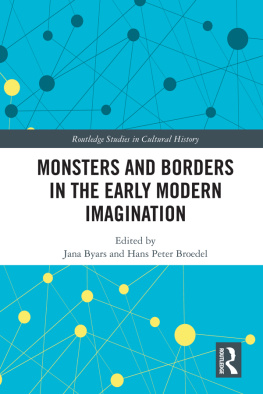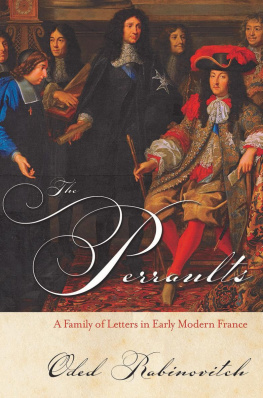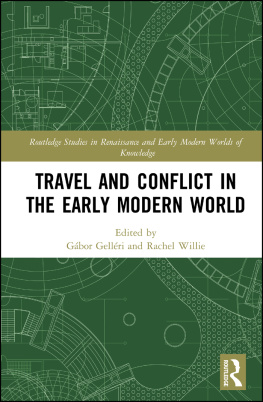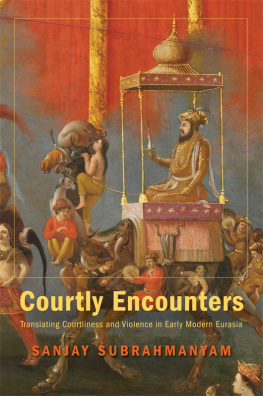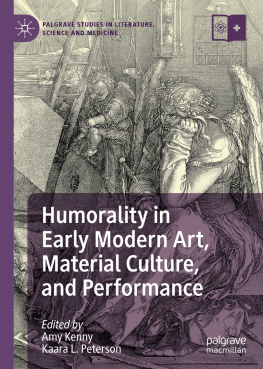Monsters and Borders in the Early Modern Imagination
This edited collection explores the axis where monstrosity and borderlands meet to reflect the tensions, apprehensions, and excitement over the radical changes of the early modern era. The book investigates the monstrous as it acts in liminal spaces in the Renaissance and the era of Enlightenment. Zones of interaction include chronological changefrom the early New World encounters through the seventeenth centuryand cultural and scientific changes, in the margins between national boundaries, and also cultural and intellectual boundaries.
Jana Byars is an independent scholar based in Amsterdam.
Hans Peter Broedel is an Associate Professor at the University of North Dakota.
Routledge Studies in Cultural History
Respectability as Moral Map and Public Discourse in the Nineteenth Century
Woodruff D. Smith
The British Anti-Psychiatrists
From Institutional Psychiatry to the Counter-Culture, 19601971
Oisn Wall
Cultural Histories of Crime in Denmark, 1500 to 2000
Edited by Tyge Krogh, Louise Nyholm Kallestrup and Claus Bundgrd Christensen
Fascism and the Masses
The Revolt Against the Last Humans, 18481945
Ishay Landa
The Irish and the Origins of American Popular Culture
Christopher Dowd
The Medieval and Early Modern Garden in Britain
Enclosure and Transformation, c. 12001750
Edited by Patricia Skinner and Theresa Tyers
Historical Memory of Central and East European Communism
Edited by Agnieszka Mrozik and Stanislav Holubec
War Experience and Memory in Global Cultures Since 1914
Edited by Angela K. Smith and Sandra Barkhof
Libraries, Books, and Collectors of Texts, 16001900
Edited by Annika Bautz and James Gregory
Monsters and Borders in the Early Modern Imagination
Edited by Jana Byars and Hans Peter Broedel
For more information about this series, please visit: www.routledge.com/Routledge-Studies-in-Cultural-History/book-series/SE0367
Monsters and Borders in the Early Modern Imagination
Edited by Jana Byars and Hans Peter Broedel
First published 2018
by Routledge
711 Third Avenue, New York, NY 10017
and by Routledge
2 Park Square, Milton Park, Abingdon, Oxon OX14 4RN
Routledge is an imprint of the Taylor & Francis Group, an informa business
2018 Taylor & Francis
The right of the editors to be identified as the authors of the editorial material, and of the authors for their individual chapters, has been asserted in accordance with sections 77 and 78 of the Copyright, Designs and Patents Act 1988.
All rights reserved. No part of this book may be reprinted or reproduced or utilised in any form or by any electronic, mechanical, or other means, now known or hereafter invented, including photocopying and recording, or in any information storage or retrieval system, without permission in writing from the publishers.
Trademark notice: Product or corporate names may be trademarks or registered trademarks, and are used only for identification and explanation without intent to infringe.
Library of Congress Cataloging-in-Publication Data
A catalog record for this book has been requested
ISBN: 978-1-138-61089-7 (hbk)
ISBN: 978-0-429-46551-2 (ebk)
Typeset in Sabon
by Apex CoVantage, LLC
Contents
HANS PETER BROEDEL AND JANA BYARS
ROBERT C. SCHWALLER
HANS PETER BROEDEL
ELIZABETH A. LISOT-NELSON
LINDA L. CARROLL
RICHARD E. KEATLEY
JESSICA OXENDINE
ELENA DANIELE
JANA BYARS
JUDITH BONZOL
KATHLEEN LONG
AMANDA BOYD
This collection grew out of a session at the Sixteenth Century Studies Conference in New Orleans, in October, 2014. Three years and countless emails later, we can say with authority that there is no such thing as a quick side project. Happily, the joys of working with such a lovely group of scholars and exploring such a fascinating topic have far outweighed the frustrations of moving commas about and standardizing citation styles.
The editors would like to thank Max Novick, as well as the anonymous readers who helped shape the individual essays as well as the volume as a whole. Broedel offers his sincere thanks to Ms. Cynthia Schulte for her generous support of historical research at University of North Dakota. Byars offers much gratitude to Robert C. Schwaller, who worked with her on the original Benzoni project, Brenna Buchanan and Ken Shonk, who offered helpful suggestions, and some outstanding students who have engagedsometimes against their willwith ideas about monstrosity over the past decade. Trevin Ward, thank you for never once telling me to stop nattering on about the monsters book.
Hans Peter Broedel and Jana Byars
In passed days I wrote very fully to you of my return from new countries, which have been found and explored with the ships, at the cost and by the command of this Most Serene King of Portugal; and it is lawful to call it a New World, because none of these countries were known to our ancestors, and to all who hear about them they will be entirely new. For the opinion of the ancients was, that the greater part of the world beyond the equinoctial line to the south was not land, but only sea, which they have called the Atlantic; and even if they have affirmed that any continent is there, they have given many reasons for denying it is inhabited. But this opinion is false, and entirely opposed to the truth. My last voyage has proved it, for I have found a continent in that southern part; full of animals and more populous than our Europe, or Asia, or Africa, and even more temperate and pleasant than any other region known to us.1
So wrote Amerigo Vespucci in a published letter known as Mundus Novus. Though Christopher Columbus never publicly admitted that what he had found was a new continent, his contemporaries quickly did. Vespucci first used the term, New World, and first posited that the Indies were, indeed, a completely new thing, one never before seen by European eyes. Vespucci wrote a short travel narrative of his own with Mundus Novus, describing the novelties of this newfound world candidly and with excitement. He provided solid evidence for this bold assertion and few readers of his treatise could have believed him to be incorrect. And, thus the European worldview was shattered.
In Marvelous Possessions, Stephen Greenblatt labels the response of Europeans, both the travelers and readers, as, intense wonder something like the startle reflex one can observe in infants: eyes widened, arms outstretched, breathing stilled, the whole body momentarily convulsed.2 This compelling image invokes the ambiguity of the response, as Greenblatt goes on to describe. Acquisition was present, certainly, as the discoverer reached to grasp and capture novelty. But the stilled breathing and the wide eyes also tell of fear, perhaps even a nascent horror. The unknown is replete with possibility but the uncharted lands could and very often did contain misery and death.
Indeed, Vespucci manifested that wonder himself in his many letters. He complimented the appearance of the indigenous he had stumbled upon after a fashion. He described their bodies as, well-formed and proportioned, and their faces, comely. Immediately following, however, he noted that this comely face was often destroyed, for they bore their cheeks, lips, noses and ears. He finished his commentary: But if you could see a thing so unwonted and monstrous you would not be without wonder.3 Here is the crux of the issue: the wonder at what is perceived to be monstrous. It is not as if Vespucci was completely unfamiliar with body decoration. European women had been piercing their ears and setting them with shiny jewels since at least the days of the ancient Egyptians. But in the New World strange stones protruded from different places on male faces as well as female. This was a fairly mild example of the startle reflex cataloguing one of the first oddities Vespucci encountered. He was not alone in his bafflement about the bodies or customs of the people in the Americas.

